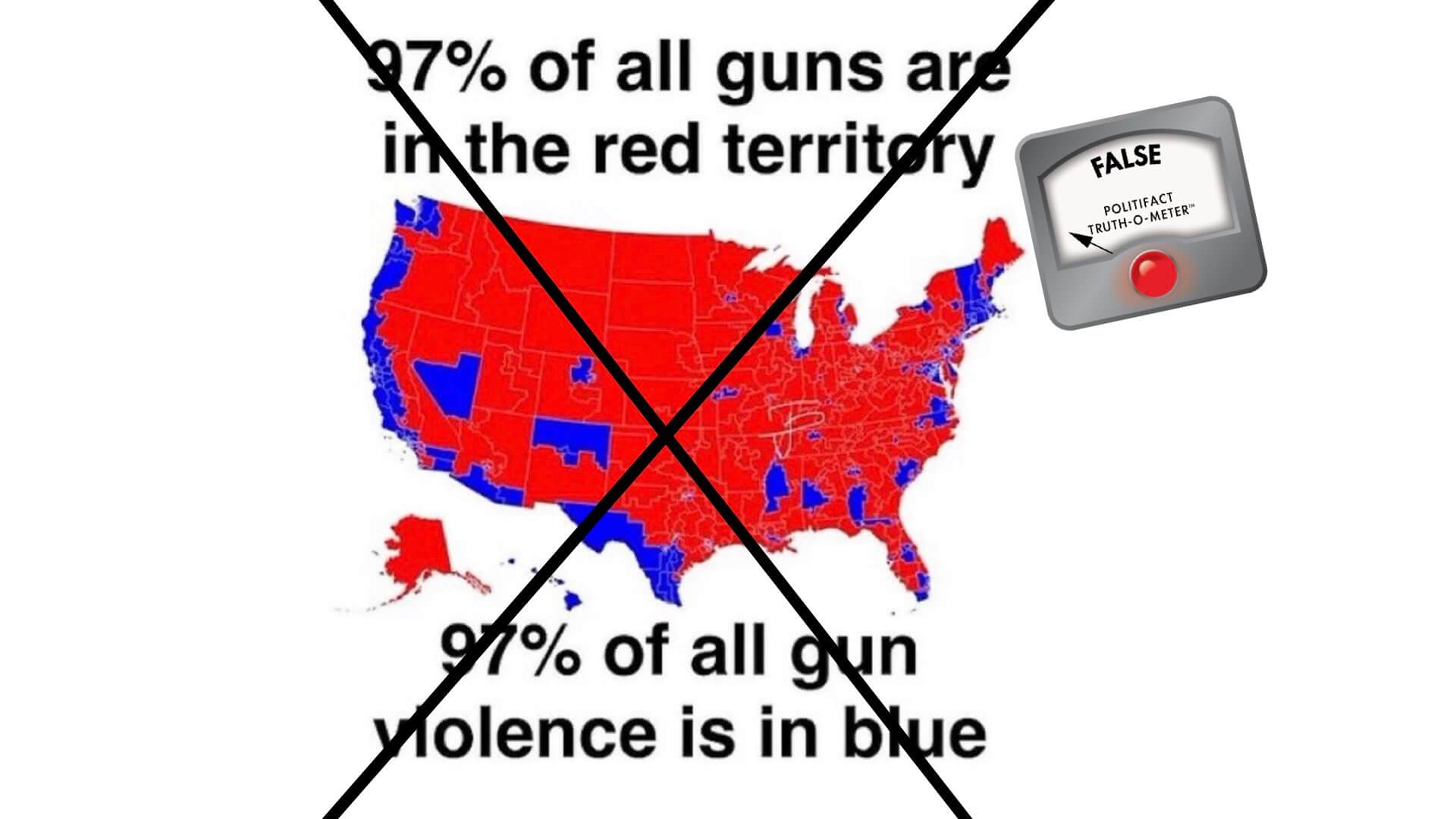A map claiming to show levels of gun violence across the United States says that states with more guns have lower levels of gun violence. But data shows that states with more gun ownership have higher rates of firearm deaths.
Instagram users shared an image of the map with text that read, “97% of all guns are in the red territory. 97% of all gun violence is blue.”
Portions of the map appeared to be divided by counties, with most of the blue regions where 97% of gun violence is allegedly occuring in areas of Democratic-led states such as California, Hawaii, Maryland, Michigan, New York, Vermont, Virginia and Washington.

(Screenshot/Instagram)
The red regions, which purport to show where “97% of all guns are,” were largely in Republican states such as Mississippi, Louisiana, Alaska, Arkansas and Tennessee. But some blue-marked counties were in Republican states such as Texas and Florida.
This post was flagged as part of Meta’s efforts to combat false news and misinformation on its News Feed. (Read more about our partnership with Meta, which owns Facebook and Instagram.)
The graphic did not cite what statistics were used to create the map. But the map is not related to gun violence statistics. As Lead Stories found, it was created by a Medium blogger to show the results by congressional district of the 2016 presidential election between Hilary Clinton and Donald Trump.
David Hemenway, director of Harvard University’s Injury Control Research Center and a firearm injury prevention expert, said there is no data on the number of firearms in each county, as the map suggests.
Because most states do not require gun owners to register their firearms, firearm registrations do not signal how many guns are in each state, reports Giffords Law Center, a nonprofit promoting gun safety legislation created by former Rep. Gabby Giffords, D-Ariz., after she was shot during a 2011 mass shooting.
Charles Branas, director of Columbia University’s Center for Injury Science and Prevention and a member of the Regional Gun Violence Research Consortium, said because there is no data collected on county-based gun ownership across the U.S., researchers will use gun manufacturing data and gun-related suicide rates as proxies for gathering region-specific gun ownership data.
The map also does not specify the type of gun violence. Branas said gun deaths are separated into three basic categories: homicide, accidental death and suicide.
The Gun Violence Archive collects data on firearm injuries and fatalities. Its database shows that in 2024, there have so far been 18 firearm injuries and eight firearm deaths in Massachusetts and 151 gun injuries and 98 gun deaths in Louisiana. Massachusetts has a population of more than 7 million people, and Louisiana has a population of more than 4.5 million people according to U.S. Census data.
The Centers for Disease Control and Prevention, which publishes the most reliable statistics on gun deaths, shows that in 2022 Mississippi, Louisiana, New Mexico and Alabama were the states with the highest firearm death rates, and Massachusetts, Hawaii, New Jersey and New York had the lowest gun death rates.
Those statistics show the map’s claims are reversed, with states that it purports to have the lowest levels of gun violence having the highest levels of gun deaths.
Branas said the map shared on social media “doesn’t coincide with anything else we’ve seen.” A report on U.S. gun violence in 2021 by the Johns Hopkins Center for Gun Violence Solutions found that states with the highest gun death rates “tend to be states in the South or Mountain West, with weaker gun laws and higher levels of gun ownership, while gun death rates are lower in the Northeast, where gun violence prevention laws are stronger.”
Cass Crifasi, co-director of Johns Hopkins Center for Gun Violence Solutions, echoed Branas’ assessment: “There is no evidence to support the claim that more guns equals less violence,” Crifasi told PolitiFact. “In fact, the opposite is true. In places with higher levels of gun ownership, we see higher rates of gun deaths.”
Crifasi said several factors contribute to gun violence, with the biggest being easy access to guns. Gun violence is more prevalent in areas with social vulnerability, she said.
Hemenway pointed to multiple studies, some of which he authored, that show U.S. households with guns have a higher likelihood of homicides, accidental gun deaths and suicides than U.S. households without guns.
The map also appeared to show that regions with large populations have higher gun violence. PolitiFact previously found that if only gun homicides are examined, big cities do account for a disproportionate amount of gun deaths.
But Branas said there are more gun suicides than there are gun homicides annually in the U.S. “In the past 20 years there’s been such a growth in suicides, that the risk in our small towns of gun death broadly, mostly driven by gun suicides, is now higher than the risk of gun death in our big cities,” Branas said.
A Harvard’s School of Public Health report looked state-by-state at the median percentage of households with guns and rates of suicides. It found that the three states with the highest gun prevalence, Wyoming, Montana and Alaska, were also in the top four states with the highest suidice rates. The report also found that the nine states with the lowest gun prevalance also had the lowest suicide rates.
None of the experts that PolitiFact consulted with had seen the data to which the map on Instagram referred.
We asked 97Percent, a nonprofit that connects gun owners and researchers to reduce gun deaths, to ask if it was familiar with the image and claim. Spokesperson Stephanie Cunnane said 97Percent had no connection to the map and called the graphic misleading, partly because it identifies Hawaii and Massachusetts as having high levels of gun violence although those states have the nation’s lowest gun violence rates.
We rate the claim that states that have 97% of guns are the states with the least amount of gun violence False.
This fact check was originally published by PolitiFact, which is part of the Poynter Institute. See the sources for this fact check here.







